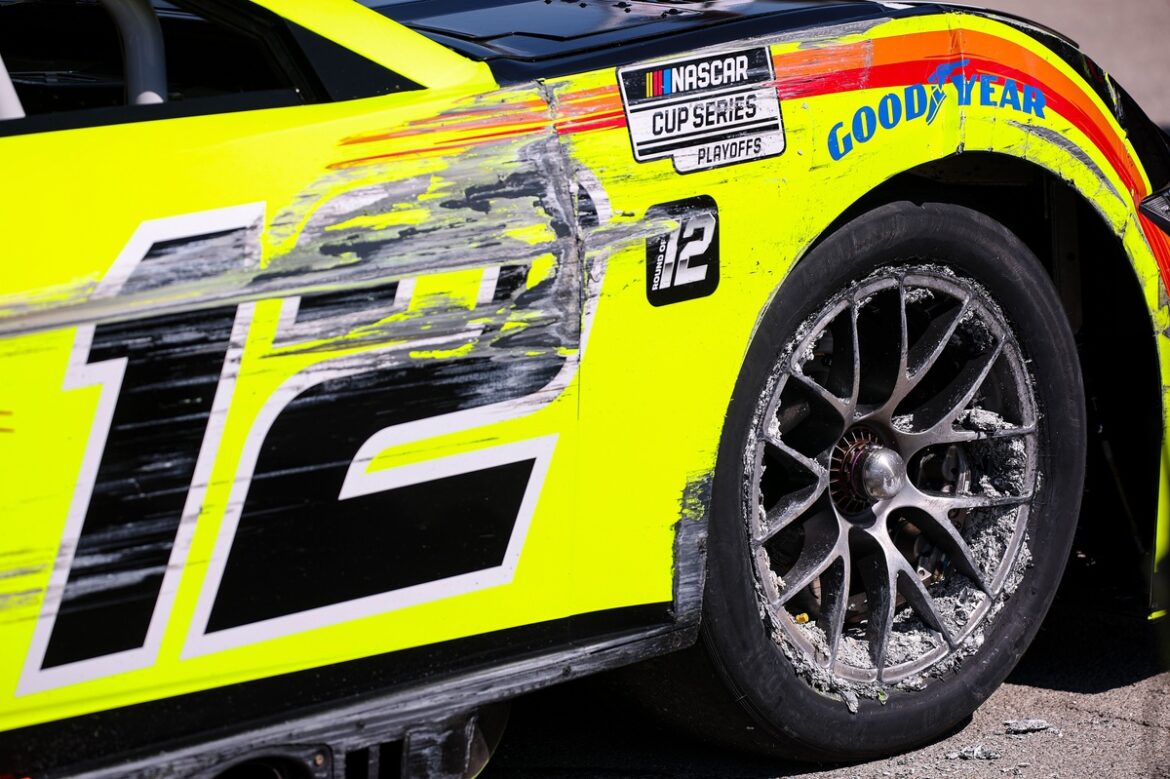Ryan Blaney and Team Penske: Navigating Challenges at Kansas Speedway
Ryan Blaney, a prominent driver for Team Penske, has already secured his spot in the Round of 8, following a stellar performance in New Hampshire. This achievement provides Blaney and his team with a sense of relief, even as they face unforeseen challenges during the NASCAR Cup practice at Kansas Speedway. Just four laps into the session, disaster struck when the No. 12 Team Penske Ford suffered a tire failure, resulting in a hard collision with the outside wall at the exit of Turn 2.
The Incident at Kansas Speedway
Blaney’s unfortunate crash forced him into a backup car, meaning he would start the race from the back of the field. After being evaluated at the infield care center, Blaney spoke with USA Network about the incident. He expressed his disappointment over the crash but remained optimistic about the team’s ability to regroup.
"Blew a tire," he noted, indicating that the team would need to investigate the cause of the tire failure. Blaney expressed frustration at having to replace a race car but emphasized his determination to analyze the situation and make the necessary adjustments for the upcoming race.
This tire failure was particularly perplexing for Blaney, as he had not noticed anything unusual before the tire went flat. He speculated that the issue might have been due to aggressively low air pressures, a problem that was prevalent during the first race at Kansas earlier in the season.
"It had that normal feeling to it before it blew," Blaney explained. “That’s kind of the hard thing about it. When you blow tires like that, they don’t feel off, and then they just give out the next moment… just unfortunate. I hate that we have to get a backup out and do all that deal. We’ll fight through it though, and I’m just looking forward to getting out there tomorrow and seeing what we got.”
The Team’s Resilience
Blaney’s situation was not an isolated incident during the practice session. His fellow Penske teammate, Joey Logano, experienced a flat tire as well. Logano, a three-time and defending champion, noticed his right-rear tire losing pressure and managed to slow down on the front stretch, avoiding a potentially catastrophic crash.
"I felt it starting to feel funky through (Turns) 3 and 4 there," Logano recounted. "Just didn’t feel right, so I lifted off the corner. Glad I caught it there. Overall, we should be okay. We’ll put on four tires, make some adjustments, cross our fingers, and hope she runs good (laughs)."
Logano’s calm demeanor in the face of tire issues demonstrates the resilience and experience of the Penske team. As a precautionary measure, Austin Cindric, the third driver for Team Penske, chose not to continue participating in the practice session. He is currently 19 points below the cut line, while Logano is in a more secure position, 24 points above it.
"Bit of a concerning session in a lot of ways as a team, but this place is pretty crazy for that," Cindric remarked after practice. His comments highlight the unpredictable nature of racing at Kansas Speedway, where tire management is crucial for success.
Tire Management in NASCAR Racing
Tire management is a critical aspect of NASCAR racing, particularly on tracks like Kansas Speedway, which features a mix of high-speed straights and challenging turns. Drivers must carefully monitor tire pressures and wear throughout the race to ensure optimal performance and prevent issues like blowouts.
The challenges posed by tire management are compounded by the unique characteristics of each racetrack. Kansas Speedway, with its relatively new surface and banking, can create varying levels of grip, depending on track conditions and weather. Teams often experiment with different tire pressures and setups during practice sessions to find the best possible configuration for the race.
When tire pressures are set too low, it can lead to overheating and ultimately result in tire failure. This is particularly concerning during long runs when the tires are subjected to continuous stress. Teams must strike a delicate balance between competitive performance and tire longevity to succeed.
The Road Ahead for Blaney and Team Penske
As Blaney prepares to race from the back of the field, the focus will be on making strategic decisions during the race. Starting in a less favorable position poses challenges, but it also presents opportunities for gaining valuable experience and showcasing driving skills.
The team will likely employ a strategy that prioritizes tire conservation, allowing Blaney to navigate through the field without risking further tire issues. Effective communication between the driver and the pit crew will be essential, as they will need to adapt to changing track conditions and monitor tire performance closely.
Blaney’s positive attitude and determination to overcome setbacks will be instrumental in the upcoming race. Despite the misfortunes during practice, he remains committed to pushing forward and making the most of the situation. The Penske team’s depth and experience will also play a vital role in their ability to adapt and strategize effectively.
Conclusion
Ryan Blaney and Team Penske have faced a series of challenges during the NASCAR Cup practice at Kansas Speedway, but their resilience and commitment to the sport shine through. With Blaney already secured in the Round of 8, the focus now shifts to overcoming the obstacles presented by tire issues and starting from the back of the field. As the team prepares for the race, tire management, strategic decision-making, and effective communication will be crucial in navigating the complexities of Kansas Speedway. While the road ahead may be challenging, Blaney’s determination and the Penske team’s experience will undoubtedly play a significant role in their pursuit of success.
